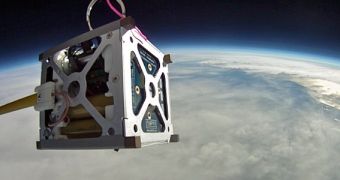Officials with the American space agency announce that their fifth PhoneSat spacecraft is now ready to be launched into space on Sunday, March 16. Spacecraft in this series are built to test the efficiency of using smartphones as control units for small-scale satellites, rather than the complex computers that are usually employed for such applications.
The new spacecraft is called PhoneSat 2.5, and is scheduled to be lofted into space aboard an unmanned Dragon space capsule, developed by Space Exploration Technologies Corporation (SpaceX) in Hawthorne, California. The Dragon will be ferried into low-Earth orbit aboard a Falcon 9 medium-lift delivery system.
The spacecraft are scheduled to launch from the Cape Canaveral Air Force Station (CCAFS) in Florida on Sunday, and should reach the vicinity of the International Space Station on March 18. Since Dragon cannot dock to the station autonomously, Expedition 39 crew members will use the CSA-built Canadarm-2 robotic arm on the orbital outpost to grapple the capsule, and berth it soon afterwards.
This resupply flight, designated SpaceX CRS-3, is the third mission the private space company will conduct to the space lab, under a $1.6 billion (€1.15 billion) Commercial Orbital Transportation Services (COTS) agreement SpaceX signed with NASA.
The main payloads on this Dragon flight are the Optical Payload for Lasercomm Science (OPALS) and the High Definition Earth Viewing (HDEV) package. The former is a very important laser communication demonstrator, which was built to support the long-term NASA effort to switch from radio to optical wavelengths when it comes to staying in touch with its spacecraft.
PhoneSat 2.5 is a part of the secondary payloads list, which features multiple other satellites, including the KickSat CubeSat. Once deployed in space, this asset will seek to demonstrate the efficiency of suing smartphone components for conducting various studies of Earth, including of its radiation environment. The CubeSat will also assess a new space-based communications system.
The small-scale satellite will fly at altitudes of up to 354 kilometers (220 miles) above Earth's surface.
“If I showed PhoneSat to you, you'd ask, ‘where's the phone?’ That's because although we buy a smartphone off the shelf, much like the one in your pocket or purse, we take it apart and repackage it to fit in the cubesat form and work in space. This differs from the first PhoneSat, that packed in the entire smartphone,” says Bruce Yost.
The expert, who is based at the NASA Ames Research Center (ARC) in Moffett Field, California, is the manager of the Small Spacecraft Technology Program at NASA. The small spacecraft is being launched as part of the American space agency's Cubesat Launch Initiative.
“NASA is using these pioneering small spacecraft missions to gauge the use of consumer-grade smartphone technology as the main control electronics of a capable, yet very low-cost, satellite,” comments SSTP program executive, Andrew Petro.

 14 DAY TRIAL //
14 DAY TRIAL //